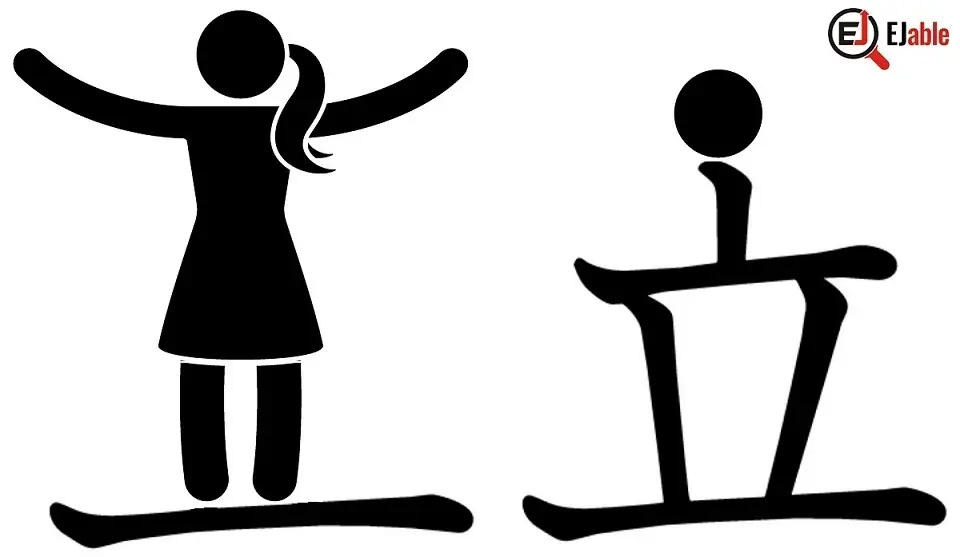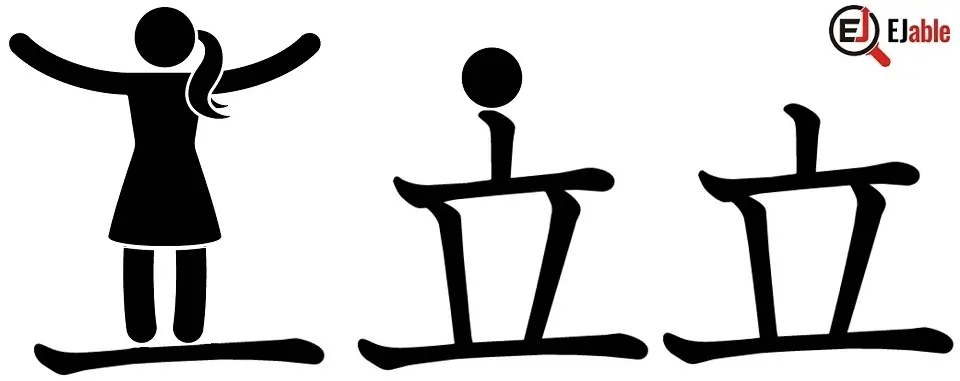Kanji for Standing Up or to Stand (立, Tachi, Tate, Ritsu)

The Kanji for Stand up or to stand as a verb is 立. The kanji 立 has a few pronunciations in Japanese. They are:
- たち (tachi): This is the kun’yomi or the native Japanese reading. It’s often used when the kanji appears on its own or in native Japanese words.
- たて (tate): Another kun’yomi reading, often seen in compounds or phrases.
- りつ (ritsu): This is the on’yomi or the reading derived from Chinese. It’s typically used in compound words (jukugo).
The appropriate reading is determined by the context in which the kanji appears. For instance, the word 立つ (to stand; to rise; to stand up) is read as “tatsu.” In the word 立法 (legislation), it’s read as “rippō.”
The Kanji 立 is constructed with 5 strokes. It is a part of the JLPT N4 syllabus (please check the JLPT N4 kanji list). In Japanese schools, this Kanji is taught in grade 1.
This article will discuss the origin of the Kanji “to stand” and easy ways to remember it. We will also discuss the radicals of this Kanji and the compounded words in which 立 kanji appears.
Origin of the Kanji 立
The original oracle bone script for 立 portrayed a figure with outstretched legs, symbolizing the act of standing. Over the millennia, the script went through various iterations. By the time it reached the clerical script used during the Han dynasty, the character had evolved to a form closely resembling the modern version.
The character beautifully simplifies the image of a person standing upright. This idea of upward motion or elevation is consistent throughout its many meanings and uses.
Kanji 立: A Closer Look
Philosophical Implications:
In East Asian cultures, particularly in Confucian thought, standing upright has moral and ethical connotations. To “stand upright” is a physical act and an emblem of morality, righteousness, and uprightness in character.
Extensions of Meaning:
Apart from “standing” or “stand up,” the kanji 立 can also convey other related concepts, such as “rise,” “establish,” “set up,” or “erect.” Its meaning often extends to figurative uses, like “to establish” (as in setting up a rule or institution) or “to commence” (as in starting a particular endeavor or activity).
Whether it’s erecting a building or instituting a new law, the action indicates stability and permanence.
Similarly, in the context of time, 立 can signify the beginning or start, as in 立春 (risshun), which refers to the beginning of spring.
How to Remember Kanji for Standing (立)

As mentioned in the section about the origin of the Kanji to stand or rise, it’s quite simple to remember the Kanji 立 by considering the following:
1) Horizontal line at the bottom as the ground
- Two vertical lines above the ground as the legs of the person
- The horizontal line above and the little vertical line at the top as the upper body, including the shoulders and head
立 as a Kanji Radical
The kanji 立 (“standing” or “stand up”) can also act as a Kanji radical and component in other Kanji characters. When used as a radical or component, it often retains some aspect of its inherent meaning, implying an upright position, standing, or rising.
Overall, 立 appears as a radical or subcomponent in 350 Kanji characters, including 65 Jōyō Kanji.
Examples of Japanese Kanji with 立 as a radical
- 新 (atara-shii, ara-ta, nii or Shin): Meaning new
- 竜 (ryū): Dragon. Here, the 立 radical can be thought of as the upright posture of a dragon.
- 競 (kyō): Compete. It contains elements suggesting people standing next to each other in competition.
- 竟 (kyō): End, ultimately. A notion of standing at the end or the final point.
- 竢 (si): Measure of volume, though this character is more frequently encountered in Chinese than Japanese.
- 竪 (tate): Vertical, upright.
- 競競 (keikei): Striving, but it’s relatively uncommon.
- 竭 (ketsu): Exhaust, use up. The implication might be of standing until one can no longer stand.
- 端 (tan, hata): Edge, tip, beginning. There’s an element of standing at the start or edge.
- 竷 (kan): Compare, compete.
- 竸: Another variant meaning competition.
- 竲: To rise, stand tall. This character is not common in modern usage.
立 in Compounded Japanese Words
The kanji 立 for standing (tachi, or ritsu in some readings) has found its way into various compound words in the Japanese language. There are 300 Japanese words that begin with the Kanji 立, and it appears in 1020 words. Here are some compounded words incorporating the 立 kanji:
- 立場 (tachiba): Position or standpoint
- 立派 (rippa): Splendid, fine
- 立体 (rittai): Solid, three-dimensional object
- 起立 (kiritsu): Standing up
- 建立 (konryū): Erect, build, establish (like a statue or a monument)
- 成立 (seiritsu): Establishment, conclusion
- 立命 (ritsume): Destiny, fate, life’s calling
- 対立 (tairitsu): Confrontation, opposition, antagonism
- 立法 (rippō): Legislation, enactment of laws
- 立案 (rian): Drafting (a plan), proposing (an idea)
- 立脚 (rikkyaku): Standing on, based on (like basing an argument on a certain standpoint)
- 立直 (riichi): A term from the game of mahjong, declaring a readiness to win
- 立教 (rikkyō): Founding of a religion or doctrine
- 見立て (mitate): Likening, comparing something to something else (as in a metaphor)
- 立夏 (rikka): The beginning of summer (a term from the traditional East Asian lunisolar calendar)
Each compounded Kanji word highlights different nuances or extensions of the concept of “standing” or “establishing” something.
Check other Kanji characters on the page “How to Learn Kanji“.

A long-term ex-pat in Japan, Himanshu comes with an IT background in SAP consulting, IT Business Development, and then running the country operations of an IT consulting multinational. Himanshu is the co-founder and Managing Director of ReachExt K.K. and EJable.com. He is also an Advisory Board Member of a Silicon Valley AI/IoT startup.
